with的.独立主格结构
- 格式:ppt
- 大小:158.50 KB
- 文档页数:15
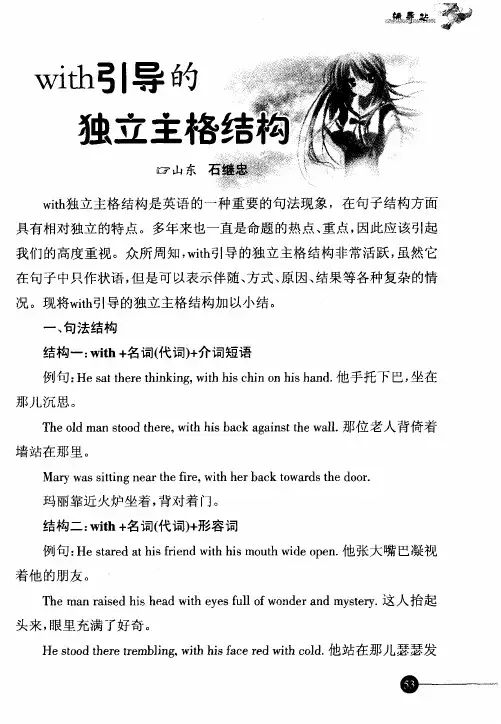
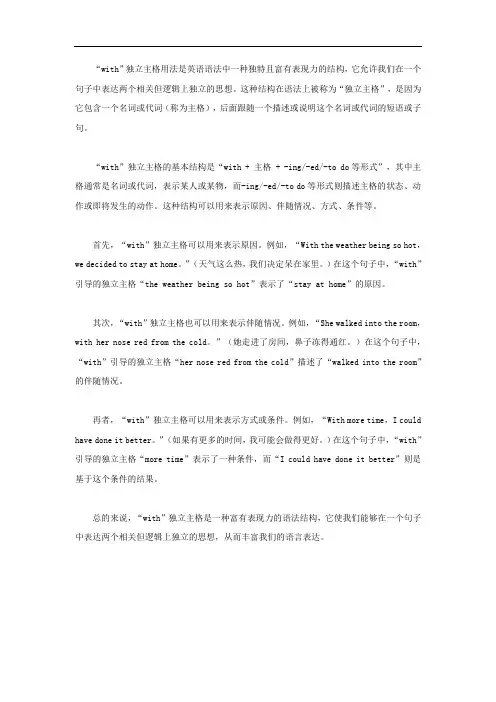
“with”独立主格用法是英语语法中一种独特且富有表现力的结构,它允许我们在一个句子中表达两个相关但逻辑上独立的思想。
这种结构在语法上被称为“独立主格”,是因为它包含一个名词或代词(称为主格),后面跟随一个描述或说明这个名词或代词的短语或子句。
“with”独立主格的基本结构是“with + 主格 + -ing/-ed/-to do等形式”,其中主格通常是名词或代词,表示某人或某物,而-ing/-ed/-to do等形式则描述主格的状态、动作或即将发生的动作。
这种结构可以用来表示原因、伴随情况、方式、条件等。
首先,“with”独立主格可以用来表示原因。
例如,“With the weather being so hot,we decided to stay at home。
”(天气这么热,我们决定呆在家里。
)在这个句子中,“with”引导的独立主格“the weather being so hot”表示了“stay at home”的原因。
其次,“with”独立主格也可以用来表示伴随情况。
例如,“She walked into the room,with her nose red from the cold。
”(她走进了房间,鼻子冻得通红。
)在这个句子中,“with”引导的独立主格“her nose red from the cold”描述了“walked into the room”的伴随情况。
再者,“with”独立主格可以用来表示方式或条件。
例如,“With more time,I could have done it better。
”(如果有更多的时间,我可能会做得更好。
)在这个句子中,“with”引导的独立主格“more time”表示了一种条件,而“I could have done it better”则是基于这个条件的结果。
总的来说,“with”独立主格是一种富有表现力的语法结构,它使我们能够在一个句子中表达两个相关但逻辑上独立的思想,从而丰富我们的语言表达。


with独立主格结构是英语中一种重要的句法现象,在句子结构方面具有相对独立的特点。
多年来也一直是命题的热点、重点,因此应该引起我们的高度重视。
众所周知,wi th引导的独立主格结构非常活跃,虽然它在句子中只作状语,但是可以表示伴随、方式、原因、结果等各种复杂的情况。
现将with引导的独立主格结构总结如下。
一、句法结构1. with +名词(代词)+介词短语He sat there thinking, with his chin on his hand.他手托下巴,坐在那儿沉思。
The old man stood there, with his back against thewall.那位老人背倚着墙站在那里。
Mary was sitting near the fire, with her back towards thedoor.玛丽*近火炉坐着,背对着门。
2. with +名词(代词)+形容词He stared at his friend with his mouth wide open.他张大嘴巴凝视着他的朋友。
The man raised his head with eyes full of wonder andmystery.这人抬起头来,眼里充满了好奇。
He stood there trembling, with his face red withcold.他站在那儿瑟瑟发抖,脸都冻红了。
3. with +名词(代词)+副词With production up by 60%, the company has had other excellentyear.产量上升了60%, 公司又是一个好年景。
The stupid Emperor walked in the procession with nothingon.这位愚蠢的皇帝一丝不挂地行进在游行队伍中。
The naughty boy stood before his teacher with hishead down.这个淘气的男孩低着头站在老师面前。
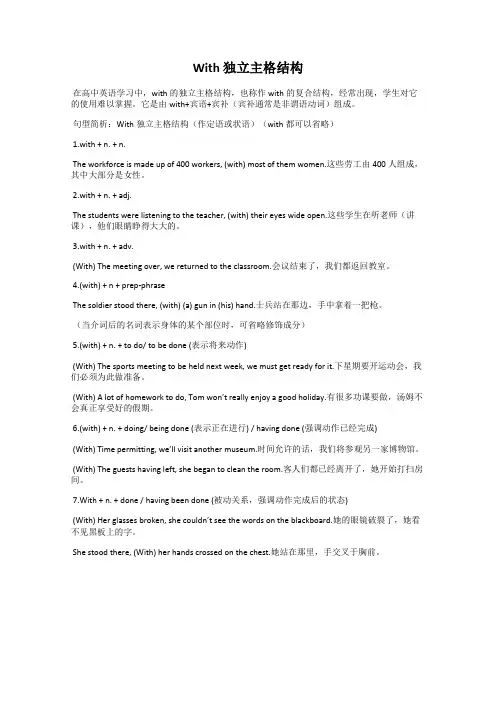
With 独立主格结构在高中英语学习中,with的独立主格结构,也称作with的复合结构,经常出现,学生对它的使用难以掌握。
它是由with+宾语+宾补(宾补通常是非谓语动词)组成。
句型简析:With独立主格结构(作定语或状语)(with都可以省略)1.with + n. + n.The workforce is made up of 400 workers, (with) most of them women.这些劳工由400人组成,其中大部分是女性。
2.with + n. + adj.The students were listening to the teacher, (with) their eyes wide open.这些学生在听老师(讲课),他们眼睛睁得大大的。
3.with + n. + adv.(With) The meeting over, we returned to the classroom.会议结束了,我们都返回教室。
4.(with) + n + prep-phraseThe soldier stood there, (with) (a) gun in (his) hand.士兵站在那边,手中拿着一把枪。
(当介词后的名词表示身体的某个部位时,可省略修饰成分)5.(with) + n. + to do/ to be done (表示将来动作)(With) The sports meeting to be held next week, we must get ready for it.下星期要开运动会,我们必须为此做准备。
(With) A lot of homework to do, Tom won’t really enjo y a good holiday.有很多功课要做,汤姆不会真正享受好的假期。
6.(with) + n. + doing/ being done (表示正在进行) / having done (强调动作已经完成)(With) Time permitting, we’ll visit another museum.时间允许的话,我们将参观另一家博物馆。
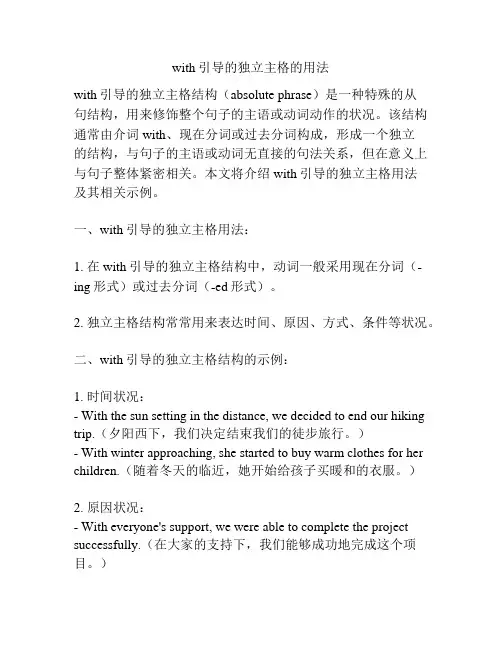
with引导的独立主格的用法with引导的独立主格结构(absolute phrase)是一种特殊的从句结构,用来修饰整个句子的主语或动词动作的状况。
该结构通常由介词with、现在分词或过去分词构成,形成一个独立的结构,与句子的主语或动词无直接的句法关系,但在意义上与句子整体紧密相关。
本文将介绍with引导的独立主格用法及其相关示例。
一、with引导的独立主格用法:1. 在with引导的独立主格结构中,动词一般采用现在分词(-ing形式)或过去分词(-ed形式)。
2. 独立主格结构常常用来表达时间、原因、方式、条件等状况。
二、with引导的独立主格结构的示例:1. 时间状况:- With the sun setting in the distance, we decided to end our hiking trip.(夕阳西下,我们决定结束我们的徒步旅行。
)- With winter approaching, she started to buy warm clothes for her children.(随着冬天的临近,她开始给孩子买暖和的衣服。
)2. 原因状况:- With everyone's support, we were able to complete the project successfully.(在大家的支持下,我们能够成功地完成这个项目。
)- With her brother's encouragement, she decided to pursue her dream of becoming a doctor.(在她兄弟的鼓励下,她决定追求成为一名医生的梦想。
)3. 方式状况:- With great care, the teacher explained the difficult concept to the students.(老师非常用心地向学生解释了这个难懂的概念。
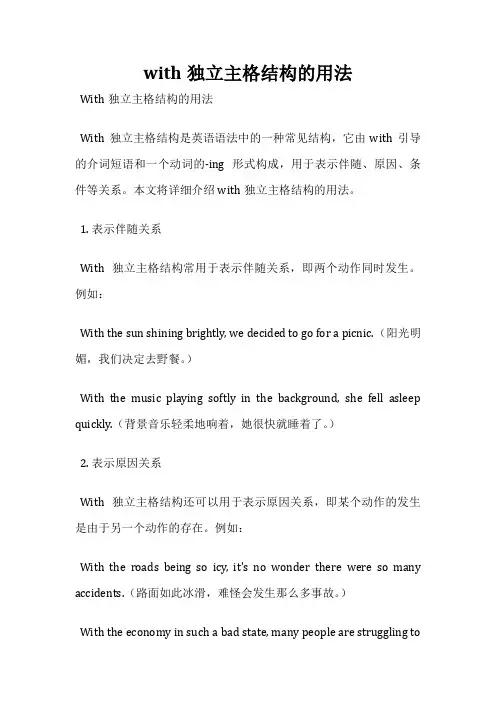
with独立主格结构的用法With独立主格结构的用法With独立主格结构是英语语法中的一种常见结构,它由with引导的介词短语和一个动词的-ing形式构成,用于表示伴随、原因、条件等关系。
本文将详细介绍with独立主格结构的用法。
1. 表示伴随关系With独立主格结构常用于表示伴随关系,即两个动作同时发生。
例如:With the sun shining brightly, we decided to go for a picnic.(阳光明媚,我们决定去野餐。
)With the music playing softly in the background, she fell asleep quickly.(背景音乐轻柔地响着,她很快就睡着了。
)2. 表示原因关系With独立主格结构还可以用于表示原因关系,即某个动作的发生是由于另一个动作的存在。
例如:With the roads being so icy, it's no wonder there were so many accidents.(路面如此冰滑,难怪会发生那么多事故。
)With the economy in such a bad state, many people are struggling tomake ends meet.(经济如此糟糕,许多人都在苦苦挣扎。
)3. 表示条件关系With独立主格结构还可以用于表示条件关系,即某个动作的发生是在某种条件下。
例如:With the weather being so unpredictable, we decided to bring both umbrellas and sunscreen.(天气如此不可预测,我们决定带上雨伞和防晒霜。
)With the deadline approaching, we worked late into the night to finish the project.(截止日期临近,我们熬夜工作以完成项目。

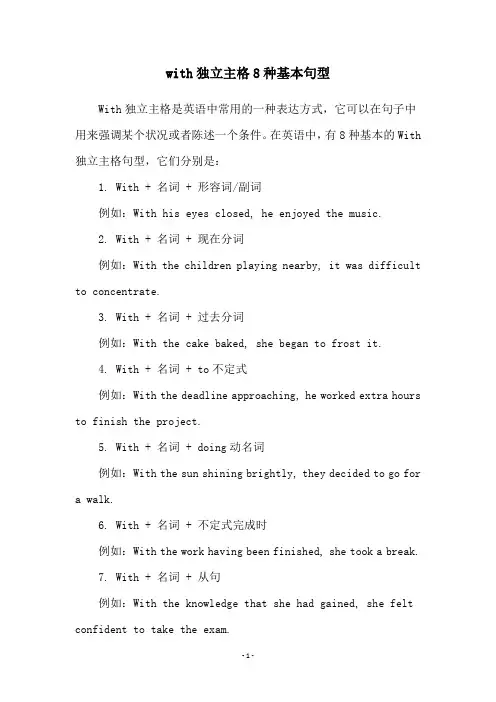
with独立主格8种基本句型With独立主格是英语中常用的一种表达方式,它可以在句子中用来强调某个状况或者陈述一个条件。
在英语中,有8种基本的With 独立主格句型,它们分别是:1. With + 名词 + 形容词/副词例如:With his eyes closed, he enjoyed the music.2. With + 名词 + 现在分词例如:With the children playing nearby, it was difficult to concentrate.3. With + 名词 + 过去分词例如:With the cake baked, she began to frost it.4. With + 名词 + to不定式例如:With the deadline approaching, he worked extra hours to finish the project.5. With + 名词 + doing动名词例如:With the sun shining brightly, they decided to go fora walk.6. With + 名词 + 不定式完成时例如:With the work having been finished, she took a break.7. With + 名词 + 从句例如:With the knowledge that she had gained, she felt confident to take the exam.8. With + 名词 + 介词短语例如:With his hand on her shoulder, he reassured her that everything would be alright.这8种With独立主格句型在英语中使用非常广泛,可以用来表达各种不同的情境和意思。
学会运用它们,能够让我们的英语表达更加地流畅自然。
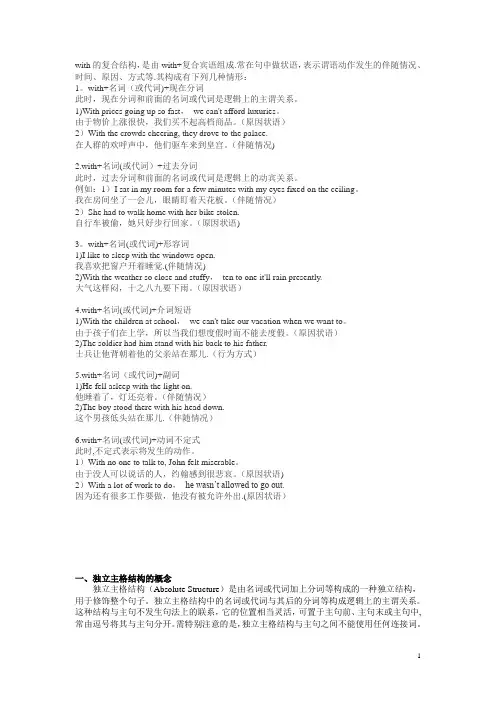
with的复合结构,是由with+复合宾语组成.常在句中做状语,表示谓语动作发生的伴随情况、时间、原因、方式等.其构成有下列几种情形:1。
with+名词(或代词)+现在分词此时,现在分词和前面的名词或代词是逻辑上的主谓关系。
1)With prices going up so fast,we can't afford luxuries。
由于物价上涨很快,我们买不起高档商品。
(原因状语)2)With the crowds cheering, they drove to the palace.在人群的欢呼声中,他们驱车来到皇宫。
(伴随情况)2.with+名词(或代词)+过去分词此时,过去分词和前面的名词或代词是逻辑上的动宾关系。
例如:1)I sat in my room for a few minutes with my eyes fixed on the ceiling。
我在房间坐了一会儿,眼睛盯着天花板。
(伴随情况)2)She had to walk home with her bike stolen.自行车被偷,她只好步行回家。
(原因状语)3。
with+名词(或代词)+形容词1)I like to sleep with the windows open.我喜欢把窗户开着睡觉.(伴随情况)2)With the weather so close and stuffy,ten to one it'll rain presently.大气这样闷,十之八九要下雨。
(原因状语)4.with+名词(或代词)+介词短语1)With the children at school,we can't take our vacation when we want to。
由于孩子们在上学,所以当我们想度假时而不能去度假。
(原因状语)2)The soldier had him stand with his back to his father.士兵让他背朝着他的父亲站在那儿.(行为方式)5.with+名词(或代词)+副词1)He fell asleep with the light on.他睡着了,灯还亮着。
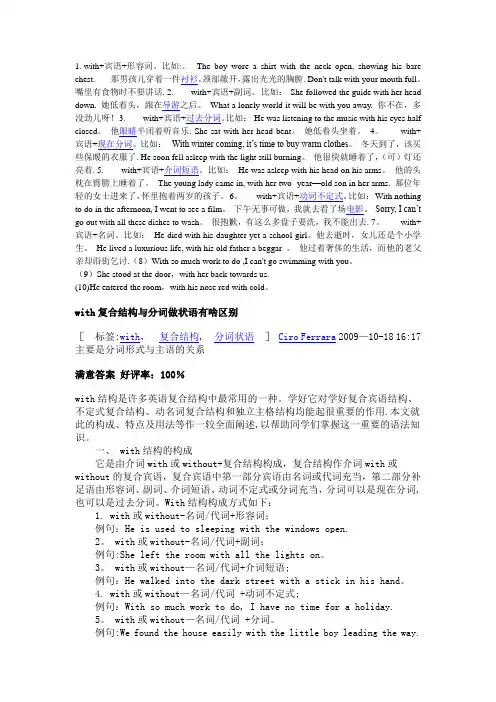
1. with+宾语+形容词。
比如:。
The boy wore a shirt with the neck open, showing his bare chest. 那男孩儿穿着一件衬衫,颈部敞开,露出光光的胸膛. Don't talk with your mouth full。
嘴里有食物时不要讲话.2. with+宾语+副词。
比如: She followed the guide with her head down. 她低着头,跟在导游之后。
What a lonely world it will be with you away. 你不在,多没劲儿呀!3. with+宾语+过去分词。
比如: He was listening to the music with his eyes half closed。
他眼睛半闭着听音乐. She sat with her head bent。
她低着头坐着。
4。
with+宾语+现在分词。
比如:With winter coming, it’s time to buy warm clothes。
冬天到了,该买些保暖的衣服了. He soon fell asleep with the light still burning。
他很快就睡着了,(可)灯还亮着. 5. with+宾语+介词短语。
比如:He was asleep with his head on his arms。
他的头枕在臂膀上睡着了。
The young lady came in, with her two- year—old son in her arms. 那位年轻的女士进来了,怀里抱着两岁的孩子。
6。
with+宾语+动词不定式。
比如:With nothing to do in the afternoon, I went to see a film。
下午无事可做,我就去看了场电影。
Sorry, I can’t go out with all these dishes to wash。
with的6种独立主格结构With的6种独立主格结构介词with在英语中的使用非常广泛,除了作为介词外,它还可以用作独立主格结构。
本文将详细介绍with的6种独立主格结构。
一、With a smile"With a smile"是最常见的一种独立主格结构,意思是“微笑着”。
这个结构通常用于描述人们的表情和态度。
例如:- With a smile on her face, she greeted everyone who entered the room.- He left the office with a smile, feeling satisfied with his day's work.二、With caution"With caution"意思是“小心地”,表示谨慎或警惕。
这个结构通常用于描述人们在行动或决策时所采取的态度。
例如:- With caution, he approached the wild animal.- She opened the package with caution, not knowing what was inside.三、With pleasure"With pleasure"意思是“乐意地”,表示愿意或高兴地做某事。
这个结构通常用于回答别人的请求或邀请。
例如:- "Can you help me move this table?" "With pleasure!"- "Would you like to join us for dinner?" "With pleasure!"四、With difficulty"With difficulty"意思是“费力地”,表示某事情很难做到,需要付出很大努力。
中考英语《句型结构》知识点:With的复合结构作独立主格在句子中,With可以引导复合结构作为独立主格来描述动作进行的方式、原因、伴随状态等情况。
下面是一些常见的使用With复合结构作独立主格的句型结构:1. With + 名词短语:用于描述动作进行的方式或条件。
例如:- With a smile, he greeted everyone in the room. (带着微笑,他向房间里的每个人问好。
)- With a lot of practice, you will improve your English. (通过大量的练习,你会提高英语水平。
)2. With + 动词的ing形式:用于描述动作进行时的伴随状态或条件。
例如:- With the baby crying, it was hard to concentrate. (宝宝在哭,很难集中注意力。
)- With the team working together, they completed the project on time. (团队一起努力,他们按时完成了项目。
)3. With + 副词/介词短语/从句:用于描述动作进行的原因或条件。
例如:- With the weather being so hot, we decided to go swimming. (由于天气太热,我们决定去游泳。
)- With the price of gas rising, many people are using public transportation. (由于汽油价格上涨,很多人使用公共交通工具。
)需要注意的是,With的复合结构作独立主格时,常与主谓语动词形成非限制性定语从句的关系,可以省略关系代词或并列连词(如that, which, and)。
希望以上内容对你有所帮助!。
with独立主格结构就是英语的一种重要的句法现象,在句子结构方面具有相对独立的特点。
多年来也一直就是命题的热点、重点,因此应该引起我们的高度重视。
众所周知,with引导的独立主格结构非常活跃,虽然它在句子中只作状语,但就是可以表示伴随、方式、原因、结果等各种复杂的情况。
现将with引导的独立主格结构加以小结。
一、句法结构【结构一】with +名词(代词)+介词短语【例句】He sat there thinking, with his chin on his hand、她手托下巴,坐在那儿沉思。
The old man stood there, with his back against the wall、那位老人背倚着墙站在那里。
Mary was sitting near the fire, with her back towards the door、玛丽靠近火炉坐着,背对着门。
【结构二】with +名词(代词)+形容词【例句】He stared at his friend with his mouth wide open、她张大嘴巴凝视着她的朋友。
The man raised his head with eyes full of wonder and mystery、这人抬起头来,眼里充满了好奇。
He stood there trembling, with his face red with cold、她站在那儿瑟瑟发抖,脸都冻红了。
【结构三】with +名词(代词)+副词【例句】With production up by 60%, the company has had another excellent year、产量上升了60%, 公司又就是一个好年景。
The stupid Emperor walked in the procession with nothing on、这位愚蠢的皇帝一丝不挂地行进在游行队伍中。
我们在阅读或在翻译一些文章的时候经常会碰到“With + 独立主格”结构,这一结构并不是一个独立的单句,但其句法作用却相当于一个单句,大多数情况下它在句子中充当状语,可以表示时间、原因、条件、让步、方式、伴随状况、附加说明等等。
这一结构在句子中即可以放在句首,也可以放在句尾。
With 后面的独立主格结构(Absolute Construction)是由名词(也可以是代词)加现在分词、过去分词、介词短语、形容词、副词、不定式等构成。
下面根据with 后独立主格所涉及到的成分通过例句的形式对这一结构加以说明。
1.With +名词+过去分词▪ They left with most of their work undone.(大部分的工作还没有做他们就离开了)▪ The year 2000 ended with nothing settled. (2000年过去了,什么也没有解决)▪ The prisoner was brought in with his hands tied and feet chained. (囚犯被带了进来,手被捆着,脚被锁链锁着。
)▪ The shopping bag ladies wear layers of clothes, with newspapersstuffed between the layers as further protection against cold.(流浪女穿着一层层的衣服,层与层之间还塞满了报纸来进一步抵御严寒)2.With +名词+现在分词▪ She stood on the top of the hill with her hair flowing in the breeze.(她站在小山顶上,长发在微风中飘拂)▪ I was about to declare myself here in Southampton with trainsrattling overhead.(在南安普敦,火车在我上面的铁轨上隆隆作响,我就要表明我自己的身份,开始拉琴卖艺了。
1.With引导的独立主格结构:with+n./pron.+现在分词(过去分词、介词短语、不定式、形容词等):其中的名词/代词就是该独立结构的主语。
而当with+n./pron.+现在分词(过去分词)时,with可省略。
这种结构一般表示伴随状态。
如She was knitting, with the television on.
这种结构可以在句首,也可以在句尾。
用逗号和主句隔开。
这种情况下,是不需要考虑逻辑主语的,with后面的名词或代词就是逻辑主语。
即使要考虑:with独立主格,充当伴随状语,一般修饰主句主语或者谓语动词
3.作状语:With+n.,句子:这时,要考虑逻辑主语和主句主语一致。
4.作状语:主语,with+n,谓语+宾语:这种情况with修饰主语,没有歧义,OG中的两个都是正确的使用。
5.作状语:主谓宾,with+n: 这里with修饰宾语。
谨慎使用,因为很容易引起歧义,即with介词短语可以修饰宾语也可以修饰主语,
2.作定语:With紧跟在名词(中心词)后面,作定语修饰,一般没有逗号隔开,作限制性修饰。
(如果有逗号隔开,应该优先考虑With介词短语作状语修饰,如果没有逗号隔开,应该优先考虑With介词短语作定语修饰前面临近的名词(中心词))
限制性非限制性区别:限制性修饰成分(具有某某属性的东东,隐含的意思是:没有此某某属性的就不是这个东东),非限制性修饰成分(某东东,此东东有某某属性)。
6.作定语:主谓宾+with短语: 此时要注意with修饰可能有歧义,with可能修饰主语或宾语。
1 With 的复合结构(with+ 复合宾语)with+ 复合宾语结构常作原因状语、伴随状语、定语等。
With + 名词/代词+名词With + 名词/代词+形容词With + 名词/代词+副词With + 名词/代词+介词短语With + 名词/代词+不定式(to do/ to be done 表示动作将要做, 若句中主语发出动作,用to do , 若句中主语不发出这一动作,则用to be doneWith + 名词/代词+现在分词(doing/ being done 表示动作与谓语动词同时进行,若是with 后的名词/代词发出动作,即所谓的主动,则用doing ; 若是被动,则用being done )With + 名词/代词+过去分词(动作已结束,动词与前面名词/代词的关系是被动) He left home, with his wife a hopeless soul.She used to sleep with the windows open.She used to sleep with the light on.She came in, with a book in her hand.With all the work to do, I don’t know if I’ll have time to go out.With the boy leading us, we soon found the house.With the house being painted, we can’t move in.With everything I needed bought, I left the shop.2 独立主格结构一般来说,我们把With 复合结构中的with 去掉,就成了独立主格结构了。
如:She slept, the windows open.The prisoner stood there, his hands raised. ( 可以这样理解:hand 是被举起的,表示被动和完成)Time permitting, We ‘ll go for a picnic.(time和permit 是主动关系)She came in, book in hand. (注: book 和hand 之前不加任何代词或冠词,这与with 复合结构不同)还有不同的是,独立主格中出现了beingIt being a fine day, we decided to go swimming.There being no bus, I had to go home on foot.这两句话中的being 是由动词be 变来的,可以这样想:独立主格也是状语,所以不能使用谓语动词。